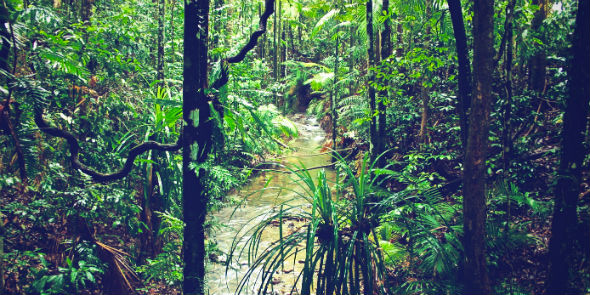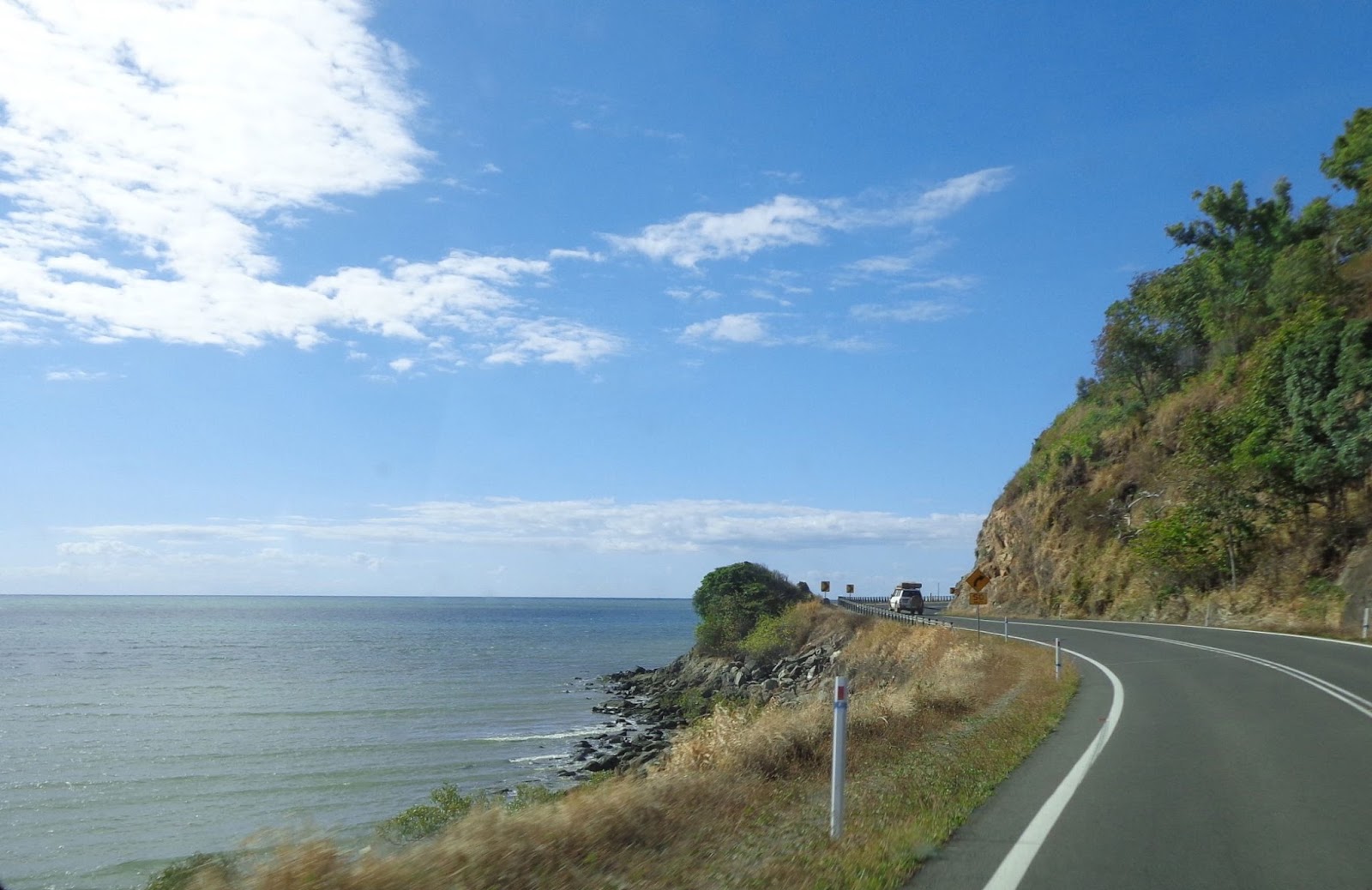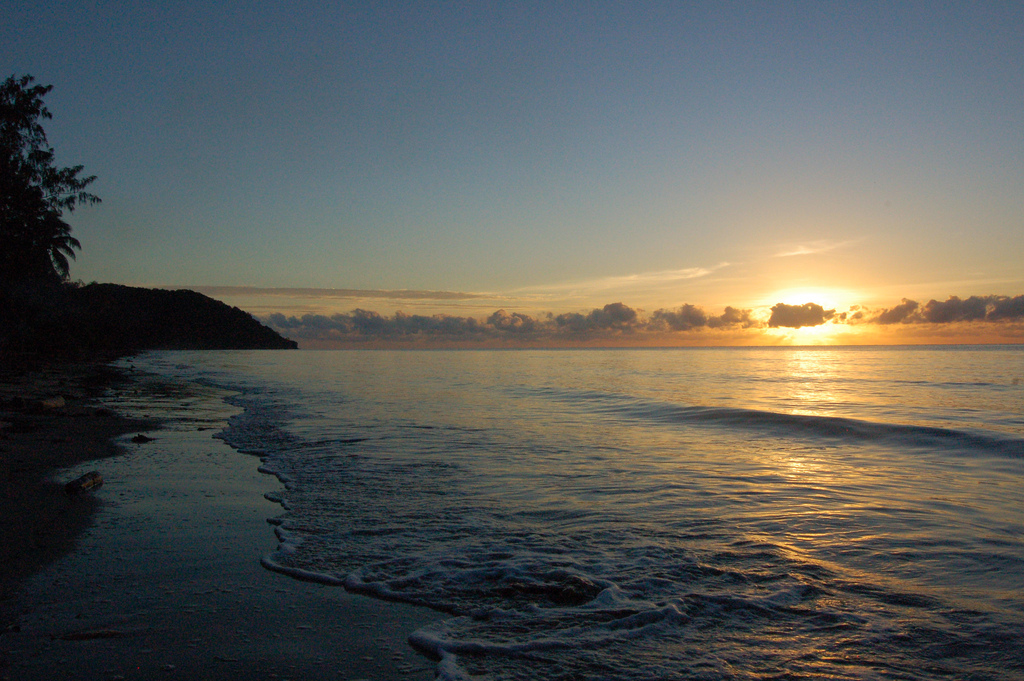December 2013 celebrated the 25th anniversary of the listing of the Wet Tropics World Heritage Area, but the Daintree is more than a World Heritage site; it is a strikingly diverse landscape of misty mountains, sacred waterfalls and rocky gorges.

Daintree Rainforest. (Photo: Paul d’Ambra via FLickr)
It’s late afternoon and the forest is bathed in quiet. Dappled light pools on the ground and flecks of gold sift through the dense canopy. In spite of myself, I am reminded of sunlight reflected on haughty glass towers in London’s financial district. But this is Queensland’s World Heritage Daintree Rainforest, and there isn’t a high-flying city suit in sight.
The Wetlands stretch languidly up the East Coast to Cape Tribulation, where sullen mangroves melt into pale turquoise ocean and ancient trees meet shores fringed with virgin coral reef. Here it feels remote, wild and far-flung from the closest city of Cairns. While Queensland’s industrial hub rests shallow industrial buildings in sandy silence, the Daintree compensates with an abundance of life, filling its canopies with all manner of threatened creatures from the forest floor to the highest treetop. It is here that I feel like an outsider, like little more than an onlooker to nature’s spectacle.
December 2013 celebrated the 25th anniversary of the listing of the Wet Tropics World Heritage Area, but the Daintree is more than a World Heritage site; it is a strikingly diverse landscape of misty mountains, sacred waterfalls and rocky gorges. Home to one of the planet’s oldest rainforests with an incredibly complex ecosystem, this land is a testament to Australia’s past. The continent was once carpeted by lush rainforest throughout, all the way into the central regions encompassing Ayer’s rock and the vast red desert that now dusts the plains. Originally part of supercontinent Gondwana, Australia drifted north into warmer latitudes, preserving pockets of rainforest habitat that remain the greatest example of Gondwana’s tropical flora.
The Daintree is a veritable living museum; a large measure of the species that inhabit the rainforest retain the original attributes of their ancestors, with some of these descendants exhibiting characteristics that date back 110 million years. There are more primitive flowering plants here than in the entire Amazon basin and within just two hectares of this rainforest, more than the total number of tree species in the whole of North America or Europe grow and thrive. The native Ribbonwood tree, for instance, also known as the ‘Green Dinosaur’, dates back to when dinosaurs roamed the earth.
A mammoth Ulysses butterfly, endemic to Australasia, lands in a patch of light on a tree trunk before me, gently fanning peacock wings of sapphire and soot. It seems a lifetime away from just hours earlier, when I sat fidgeting in the deserted Cairns airport, awaiting the appearance of my companion. Disheveled and disorientated after 37 hours spent on various planes, he trudged through arrivals, all wide eyes and mussed up hair. I hurled passports and credit cards at the car hire booth and emerged with keys to an electric blue monstrosity that would not have been entirely out of place in a Transformers film.
We spent an hour hurtling up the deserted Captain Cook Highway, flanked with lush green pastures on the left and endless beaches on the right. The good life here is simple – wound-down windows beckoning to the sea-salt breeze coupled with a few good tracks makes for satisfied spirits. Bidding farewell to the swaying palms that line the sands, we turned inland, following a straight track through the thickening greenery beside the Mossman River.

Along the Captain Cook Highway. (Photo via Flickr)
We set up camp in a stilted tree house, dark wood shaded by a full spectrum of greens. Feeling simultaneously lazy and restless, it is here that I settled for lounging in the hammock on the balcony, with a glass of passion fruit wine from nearby award-winning Shannonvale Tropical Fruit Winery. True to its name, the quirky winery concocts liquor from a rainbow of organic exotic fruits: mango, paw paw, pineapple, jaboticaba, lychee and ginger among them. The result is surprisingly mellow.
Losing focus amongst cascading greens, tall trunks and swaying vines, I feel safely cocooned beneath nature’s cloak. This is a place where sight fades into the background and other senses heighten; the rush of the river interspersed with the distant calls of concealed creatures, gentle earthy scents, stagnant humidity relieved by a slight breeze that steals through the bush and whispers against my skin. I sit static as the rainforest continues its cycle and evening sets in, absorbing sensations while the buzzing of a plethora of insects, some of over 12,000 species found here, overcomes the melodies of the river.
Eventually we emerge from our cabin, slow steps instilled with the pace of the rainforest. Night brings an eclectic combination of nocturnal voices echoing from somewhere beyond the vine curtains. Bats flit haphazardly overhead and glowing lights illuminate the fan palms, casting pointed-finger shadows on the narrow path. Dinner is served up on a wooden deck suspended over the river. Serenaded by a chorus of frogs far below, we dodge smoked crocodile and kangaroo drizzled in wild hibiscus syrup in favour of less controversial local delicacies; native nuts and seeds tossed over rainforest salad and line-caught barramundi wrapped in paperbark with spicy ginger.
Night gives way to an emerald dawn beneath the cloud-swept canopy and we rise with discovery in mind. The best guides, naturally, are the locals. The Daintree has been home to the Kuku Yalanji Aborigines for thousands of years and nature is integral to their belief systems. The tribes maintain their cultural identity whilst adopting more common contemporary practice, but their calendar remains defined according to the life cycle of plants. Before we set off, our guide Binna conducts a traditional smoking ritual around a smouldering fire to cleanse us of bad spirits. He is a walking encyclopedia, pointing out rare fauna and indigenous animals such as the secretive tree-kangaroo and the inquisitive double-eyed fig parrot. Deep in the forest, I ask why we have gone so far of the track. Binna smiles and says simply, “Paths are made by walking.”

Sunrise over Cape Tribulation (Photo: Kat Montgommery via Flickr)
We reach the mouth of a cave, shrouded by leafy undergrowth, to shed torchlight on the shadows. Ancient paintings appear of ghostly figures dancing across the walls in the yellow beam. After an hour spent attempting to master the art of spear throwing in a sunny clearing, we immerse ourselves in a rock pool – deep, clear and icy cold, encircled by egg-shaped granite tablets and towering trees. Binna squats at the edge of the pool and lets the water wash the dust from his bare feet. Looking skyward, he says, “Aboriginals have an old saying that goes, ‘May as well be here, we are as where we are.’”
More than anything, we feel alone in the Daintree, lost in an exotic and prehistoric maze. But the solitude here is spiritual and comforting, where nature’s quiet song grows loud and where time melts into the horizon hand-in-hand with the sinking Australian sun.
Where to Start
With over 7000 square miles of rainforest to cover, it’s difficult to know where to begin. Vast Jurassic beaches or thick matted jungle? Peaceful billabongs, tumbling rivers or the rugged Thornton Peak mountain? It’s all here for the picking and one of the very best ways to explore the coastline is by car. Follow the wide and empty Captain Cook Highway past surreal signposts featuring all manner of Australia’s bizarre creatures, from kangaroos to cassowaries and umbrella-sized jellyfish (stinger season runs from November to May, when many of the beaches here are off-limits). Classic self-drive routes speed through the scenic Alexandra Range and Cow Bay, with countless opportunities for hiking, bird watching and lounging on golden beaches. Highlights include the Drift River Snorkel, where lucky swimmers might catch sight of an elusive platypus. Halfway up the coast, wind up at Cape Tribulation where the rainforest meets the reef and the road morphs into a 4WD-only route along the bumpy Bloomfield Track.
Forest adventures on offer include cruising the mysterious Daintree River, spotting fascinating wildlife, rainforest picnics and jungle surfing (similar to zip-lining), all available through local operator Jungle Tours. Family business D’Arcy’s Adventures operates a classic 4WD trip to the Wujal Wujal Falls, taking in crystal clear creeks and significant indigenous cultural spots, while foodies will delight in a visit to Cape Trib Exotic Fruit Farm to taste rare organic fruit such as the fragrant Malay Roseapple and the startlingly creamy lemon meringue pie flavoured Amazonian Rollinia. Ocean Safari does what it says on the tin, with snorkelling itineraries designed to make the very most of the magnificent Great Barrier Reef, while Cape Tribulation Camping offers sea kayaking amongst mangroves and tented castaway stays on nearby Snapper Island.
For a more luxurious experience, Thala Beach Lodge takes over a private headland just moments away from the charming town of Port Douglas, while Daintree Eco Lodge is one of the most highly awarded eco accommodations in the world and Silky Oaks Lodge, located on the outskirts of the reserve, specialises in more spa treatments than you could shake a didgeridoo at. One thing is for certain; eco chic is buried beneath the skin of this captivating destination, and all the time in the world would barely scratch the surface.